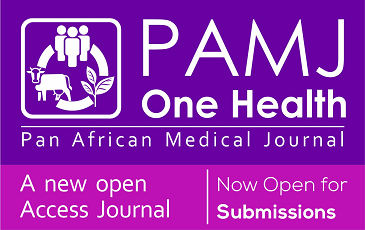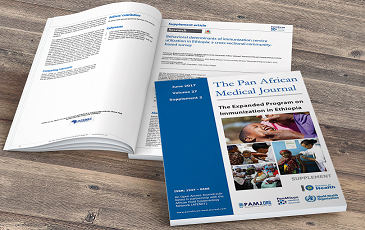Discovery of Ebstein's disease in a postpartum woman at the Cardiology Clinic of the Fann University Hospital in Dakar: a case report
Hanifa Ismael Ibouroi, Pêngd-Wendé Habib Boussé Traore, Magalie Kaya, Hassim Bachir Diop, Lamine Sy, Ibrahim Bara Diop
Corresponding author: Ismael Ibouroi Hanifa, Cardiology Department, Fann University Hospital Center, Dakar, Senegal 
Received: 30 Aug 2024 - Accepted: 06 Oct 2024 - Published: 28 Mar 2025
Domain: Radiology,Cardiology
Keywords: Ebstein´s disease, postpartum, MRI, Senegal, case report
©Hanifa Ismael Ibouroi et al. PAMJ Clinical Medicine (ISSN: 2707-2797). This is an Open Access article distributed under the terms of the Creative Commons Attribution International 4.0 License (https://creativecommons.org/licenses/by/4.0/), which permits unrestricted use, distribution, and reproduction in any medium, provided the original work is properly cited.
Cite this article: Hanifa Ismael Ibouroi et al. Discovery of Ebstein's disease in a postpartum woman at the Cardiology Clinic of the Fann University Hospital in Dakar: a case report. PAMJ Clinical Medicine. 2025;17:29. [doi: 10.11604/pamj-cm.2025.17.29.45158]
Available online at: https://www.clinical-medicine.panafrican-med-journal.com//content/article/17/29/full
Case report 
Discovery of Ebstein's disease in a postpartum woman at the Cardiology Clinic of the Fann University Hospital in Dakar: a case report
Discovery of Ebstein's disease in a postpartum woman at the Cardiology Clinic of the Fann University Hospital in Dakar: a case report
![]() Hanifa Ismael Ibouroi1,&,
Hanifa Ismael Ibouroi1,&, ![]() Pêngd-Wendé Habib Boussé Traore1, Magalie Kaya1, Hassim Bachir Diop1,
Pêngd-Wendé Habib Boussé Traore1, Magalie Kaya1, Hassim Bachir Diop1, ![]() Lamine Sy1, Ibrahim Bara Diop1
Lamine Sy1, Ibrahim Bara Diop1
&Corresponding author
Ebstein's disease is a congenital heart disease involving the tricuspid valve and right ventricle. It represents 0.3 to 0.6% of all congenital heart defects. Its prognosis varies depending on the anatomical severity, the context (fetal, newborn, infant, childhood, pregnant woman, etc.), the presence of complications (heart failure, rhythm disturbance, thromboembolic, conduction disorder, endocarditis, etc.). Echocardiography is the imaging test of choice to evaluate Ebstein's anomaly. Cardiac magnetic resonance imaging (MRI) or cardiac computerized tomography (CT) scan allows better visualization of the anatomy of the tricuspid valve and the characteristics of tricuspid insufficiency. We will first describe a case of Ebstein's disease discovered postpartum in a 33-year-old female patient. Clinically, she presented with a syndrome of right heart failure. Cardiac ultrasound and MRI confirmed the diagnosis. Secondly, to review the literature on Ebstein's disease.
Ebstein's disease is a congenital heart disease involving the tricuspid valve and right ventricle (RV) [1]. It was first described by the pathologist Wilhelm Ebstein in 1866 [1]. It represents 0.3 to 0.6% of all congenital heart defects [1] and occurs in 0.2 to 0.7 per 10,000 live births [1]. It affects the functional and vital prognosis through supraventricular rhythm disturbances, thromboembolic accidents and heart failure [1].
Patient information: it was a woman of 33-year-old patient, V gestures V pares whose last born died of unspecified causes on day 1 of extra-uterine life after a vaginal delivery.
Timeline: she consulted in our department in the second month of postpartum.
Clinical findings: she had chronic palpitations that had become continuous for 5 months and whose intensity would also have increased, plus bilateral swelling and progressive aggravation of the volume of the lower limbs for 3 weeks with exertional hepatalgia and dyspnea stage III of the New York Heart Association (NYHA). On examination, the patient was in fairly good general condition, with clear consciousness, isolated grade I diastolic hypertension at 138/95 mmHg, 96% transcutaneous oxygen saturation in room air and a heart rate of 96 beats per minute. Examination of the apparatus showed eusomal facies, no cyanosis, regular auscultatory tachycardia, a murmur of tricuspid insufficiency 2/6e, a syndrome of right heart failure consisting of spontaneous turgidity of the jugular veins, edema in the lower limbs, sensitive hepatomegaly (hepatic arrow measured on the right midclavicular line at 18 cm) with systolic expansion of the hepatic mass and jugular veins and reflux hepato-jugular.
Diagnostic assessment: the 12-lead surface electrocardiogram at admission recorded a typical, anticlockwise, fast-slow, 3:1 fixed-conduction atrial flutter (Figure 1). Biology at entry showed anemia (haemoglobin at 9 g/dl), hypochromium, microcytic and a spontaneous International Normalized Ratio (INR) dosed at 1.19. Resting transthoracic doppler echocardiography showed a significant dilation of the right atrium measured at 48 cm² with a tricuspid valve implantation much lower than the mitral one, by partial delamination of the posterior and septal tricuspid sheets, displacing the tricuspid orifice towards the apex and making a mitrotricuspid offset measured at 8 mm. The right ventricle was bipartite with a small "functional" part, and a large "atrialized" part. Significant tricuspid insufficiency was noted (Figure 2). Cardiac MRI confirmed the diagnosis of Ebstein's disease by showing significant dilation of the right atrium with low implantation of the tricuspid valve, occupying the majority of the right ventricular cavity and with a maximum volume measured at 651 ml. The "functional" right ventricle was difficult to visualize in a long cross-section, axis 4 cavities, not dilated or disorders of segmental kinetics (Figure 3). The diagnosis of Ebstein's disease complicated by a significant tricuspid insufficiency, a typical atrial flutter and a syndrome of right heart failure in a 33-year-old patient in the second month of postpartum.
Therapeutic intervention: the initial management of the patient consisted of hospitalization, the administration of a depletive treatment in this case injectable furosemide, an antiarrhythmic, an effective anticoagulation. She also received therapeutic education and effective contraception. The prospect of surgery is indicated.
Follow-up and outcomes: the course was marked clinically by the disappearance of right heart failure syndrome, electrically by the appearance of atrial fibrillation and biologically by an INR of 3.2 (Figure 4).
Informed consent: the patient has given her informed consent for the publication of this case.
The primum mavens in Ebstein's anomaly is the total or partial defect of delamination of the leaflets of the tricuspid valve during intrauterine development [2]. It mainly concerns the posterior and septal leaflets of the tricuspid valve, leading to the antero-apical displacement of the orifice and the tricuspid valve [3]. Displacement is generally defined as a displacement > 8 mm/m² of the septal leaflet relative to the anatomical tricuspid annulus [4]. This leads to having a bipartite right ventricle with the "atrialized" right ventricle (RV) and the "functional" RV [5] (Figure 5).
Cause of functional abnormalities
The clinical presentation of Ebstein's anomaly is variable, but it is usually diagnosed with cyanosis, right heart failure, or arrhythmia. While cyanosis and right heart failure are more common in the pediatric population, arrhythmia is more common in adults, such as in our patient who had atrial flutter. Transthoracic doppler echocardiography, a reference examination, provides the diagnostic elements of apical displacement of the tricuspid valve with a shift of more than 8 mm/m² with respect to the mitral valve ring in apical 4-chamber view [1,6], tricuspid regurgitation and dilation of the right atrium and the "atrialized" RV. Echocardiographic assessment of the size and function of the "functional" RV can be difficult and only a qualitative assessment is possible. Cardiac magnetic resonance imaging is a formidable contribution to the morphological and functional analysis of the right heart. It adds valuable information regarding the anatomy of the leaflets of the superior tricuspid valve to echocardiography. It also makes it possible to quantify the ejection fraction of the RV [7]. It is essential to determine the most appropriate surgical procedure. The anatomical forms of Ebstein's disease have been described by Carpentier [6] (Figure 6).
Ebstein's disease complications
Supraventricular arrhythmias: tachyarrhythmias are the first clinical manifestation in nearly 40% of people newly diagnosed with an Ebstein anomaly [6]. These are most often reentrant atrioventricular tachycardia, but also atrial fibrillation, atrial flutter and atrial tachycardia [4]. In our patient, she had atrial fibrillation.
Ventricular arrhythmias: sudden deaths due to ventricular arrhythmias have been reported with a cumulative incidence of 8.6% over 50 years from birth [5].
Conductive disorders: atrioventricular block of various degrees. Intraventricular conductive disorders with a right bundle branch block type are also possible complications. Heart failure, thromboembolic events, infective endocarditis.
Cardiac abnormalities associated with Ebstein's disease
An atrial septal defect: more than 80% of patients also have a secondary atrial septal defect or a forced patent foramen ovale [8].
Pulmonary valve stenosis: it is reported in approximately 6 to 15% of cases. It is infundibular muscular [6].
An accessory tract: accessory tracts are common, and about one-third of patients have more than one accessory tract [4]. In addition, 5-25% of patients with Ebstein's abnormality are thought to suffer from Wolff Parkinson White syndrome (WPW), making it the most common congenital heart defect associated with WPW [9]. Our patient had no associated abnormality.
The severity varities of Ebstein's disease depending on the terrain
Neonatal and infant forms: currently, only minor pauci-symptomatic forms should be diagnosed outside the fetal or neonatal period [6].
Forms of pregnant or postpartum women: pregnancy increases blood volume and thus cardiac output in the mother. This increases cardiac work and can decompensate or worsen an underlying heart disease that was previously asymptomatic or not, known or unknown. This was the case with our patient. Her 5th pregnancy was the decompensation factor for her previously unknown heart disease.
The prognosis of Ebstein's disease
The main predictors of mortality are the degree of tricuspid displacement, the extent of tricuspid regurgitation, and the duration and degree of RV dysfunction in both non-operated and early post-surgical patients [8]. Scores have been established to predict mortality from Ebstein's disease. The Celermajer score is an echocardiographic score used to assess the severity of the condition in the newborn. The higher the grade, the higher the mortality.
Surgical interventions with palliative aims (cavo-pulmonary shunts) and curative ones (conservative and non-conservative)
Conservative curative interventions
Several surgical approaches have been described for the treatment of Ebstein's anomaly. Da Silva cone reconstruction, which is the surgical approach currently preferred in young children and adults. Danielson technique involves folding the atrialized portion of the RV, thereby reducing the size of the tricuspid valve and creating a competent single-layered tricuspid valve [10].
Non-conservative curative procedures: this is a tricuspid valve replacement.
Ebstein's disease varies in severity, depending on its anatomical severity, its terrain, the presence of complications (heart failure, rhythmic, thromboembolic, conductive, endocarditic, etc.). In our patient, the postpartum has decompensated for her heart disease. Echocardiography is the imaging test of choice for evaluating Ebstein's abnormality. Cardiac MRI or cardiac computed tomography, to better visualize the anatomy of the tricuspid valve and the characteristics of tricuspid insufficiency. The prognosis of Ebstein's disease depends on the degree of the mitrotricuspid shift, the severity of tricuspid insufficiency and the dysfunction of the right ventricle. The management of the Ebstein anomaly requires strong interdisciplinary coordination.
The authors declare no competing interests.
All the authors have contributed to this work. All have read and approved the final manuscript.
Figure 1: typical atrial flutter, anticlockwise, fast-slow, with fixed conduction 3/1
Figure 2: mitro-tricuspid shift and the tricuspid insufficiency (4 truncated chambers)
Figure 3: tricuspid valve offset with a bipartite right ventricle (RV) comprising an atrialized RV and a functional RV and ectasic right atrium
Figure 4: atrial fibrillation
Figure 5: illustration of Ebstein's disease: RA: right atrium; ARV: atrialized right ventricle; TRV: true right ventricle or functional right ventricle (RVF); LV: left ventricle; LA: left atrium; d: mitro-tricuspid shift
Figure 6: carpentier's classification into 4 types of increasing severity of Ebstein's disease [6]
- Singh DP, Hussain K, Horenstein MS, Mahajan K. Ebstein Anomaly and Malformation. 2024 Feb 28. In: StatPearls [Internet]. Treasure Island (FL): StatPearls Publishing; 2025 Jan. PubMed
- Dearani JA, Mora BN, Nelson TJ, Haile DT, O'Leary PW. Ebstein anomaly review: what's now, what's next? Expert Rev Cardiovasc Ther. 2015 Oct;13(10):1101-9. PubMed | Google Scholar
- Anderson KR, Zuberbuhler JR, Anderson RH, Becker AE, Lie JT. Morphologic spectrum of Ebstein's anomaly of the heart: a review. Mayo Clin Proc. 1979 Mar;54(3):174-80. PubMed | Google Scholar
- Stephens EH, Dearani JA, Qureshi MY, Ammash N, Maleszewski JJ. The Congenital Tricuspid Valve Spectrum: From Ebstein to Dysplasia. World J Pediatr Congenit Heart Surg. 2020 Nov;11(6):783-791. PubMed | Google Scholar
- Holst KA, Connolly HM, Dearani JA. Ebstein's Anomaly. Methodist Debakey Cardiovasc J. 2019 Apr-Jun;15(2):138-144. PubMed
- Madani S, Van Linthout C, Rondia G, Seghaye MC. [Ebstein's anomaly : from fetal diagnosis to surgical treatment]. Rev Med Liege. 2020 Jan;75(1):43-48. PubMed | Google Scholar
- Kühn A, Meierhofer C, Rutz T, Rondak IC, Röhlig C, Schreiber C et al. Non-volumetric echocardiographic indices and qualitative assessment of right ventricular systolic function in Ebstein's anomaly: comparison with CMR-derived ejection fraction in 49 patients. Eur Heart J - Cardiovasc Imaging. 2016 Aug; 17(8):930-5. PubMed | Google Scholar
- Brown ML, Dearani JA, Danielson GK, Cetta F, Connolly HM, Warnes CA et al. The outcomes of operations for 539 patients with Ebstein anomaly. J Thorac Cardiovasc Surg. 2008 May;135(5):1120-36, 1136.e1-7. PubMed | Google Scholar
- Khositseth A, Danielson GK, Dearani JA, Munger TM, Porter CJ. Supraventricular tachyarrhythmias in Ebstein anomaly: management and outcome. J Thorac Cardiovasc Surg. 2004 Dec;128(6):826-33. PubMed | Google Scholar
- Danielson GK, Driscoll DJ, Mair DD, Warnes CA, Oliver WC Jr. Operative treatment of Ebstein's anomaly. J Thorac Cardiovasc Surg. 1992 Nov;104(5):1195-202. PubMed | Google Scholar










